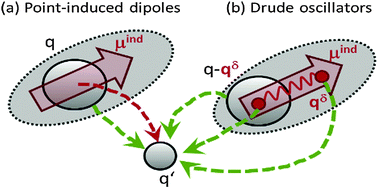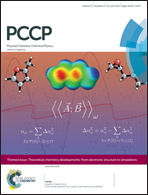Comparing induced point-dipoles and Drude oscillators†
Abstract
Classical Molecular Dynamics simulations describing electrostatic interactions only by point charges can be augmented by the inclusion of atomic polarisabilities modelling charge flexibility. Two widely used models, Drude oscillators and induced point-dipoles, are compared in a systematic study using their respective implementations in CHARMM and AMBER. The question of necessity and importance of polarisable hydrogen atoms is raised and two implementations, in an implicit or explicit manner, are compared to the case of non-polarisable hydrogen atoms. For all these polarisability models, the strength of the respective atomic polarisabilities was incremented in steps of ten percent up to their full values. The influence of polarisability on the structure and dynamics of the ionic liquid EMIM⊕CF3SO⊖3, which is chosen as a test case, is studied thoroughly. Using appropriate model functions, the respective dynamical and structural data are fitted. Thus, a small set of parameters is deduced, which highlights the effect of polarisability. Generally, flexibility of the charge distribution leads to enhanced fluidity and less pronounced structure. As this usually occurs when adding a co-solvent to an ionic liquid, the inclusion of polarisability can be seen in much the same way in that it acts like an inner solvent.

- This article is part of the themed collection: Theoretical chemistry developments: from electronic structure to simulations

 Please wait while we load your content...
Please wait while we load your content...